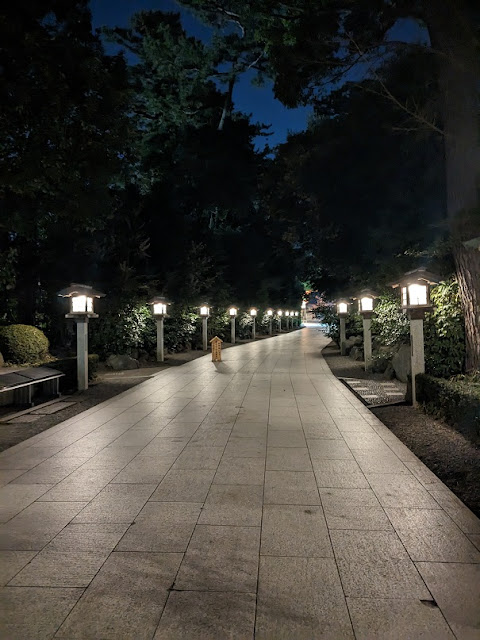 |
| Main Hall of Samukawa-jinja Shrine |
The Shinto shrine of Samukawa-jinja Shrine (寒川神社), in Samukawa, Kanagawa Prefecture, is known as the "Ichinomiya in Sagami Province." Ichinomiya refers to the highest-rank Shinto shrine in a province, an administrative division used until replaced with prefectures around the early days of the Meiji period. Sagami Province covered most of what is Kanagawa Prefecture today.
 |
| Armillary sphere (kotengi) |
It is unclear when the shrine was founded, but records show offerings being provided during the reign of Emperor Yuryaku (456 ~ 479) and a shrine building being built in 727.
 |
| Goshinboku |
The shrine enshrines the god of
Samukawahiko-no-mikoto (寒川比古命) and the goddess of
Samukawahime-no-mikoto (寒川比女命), collectively called
Samukawa-Daimyojin (寒川大明神), and has been worshipped as the deities of
Happo-yoke (八方除) which is inviting success in business and bringing better fortune by removing misfortune and disaster. "Happo (八方)" literally translates to eight directions referring to north, south, east, west, northeast, southeast, northwest, and southwest. There is a replica of an
armillary sphere (kotengi) (渾天儀), with four dragons, in front of the
Main Hall (Gosyaden) (御社殿) on the right.
The two Japanese cedars in front of the Main Hall on the left are the goshinboku.
 |
Shinmon
|
In front of the Main Hall is the Shinmon (神門), a multi-storied gate built in 1993. Normally, it is open from 6:00 AM to sunset.
 |
Minami-mon
|
 |
Shrine office
|
The Minami-mon (南門), now standing by the shrine office, used to be the Shinmon. It was built in 1929.
 |
| Shinmesha |
Standing on the left, in front of the Shinmon, is the Shinmesha (神馬舎), built to celebrate the 50th anniversary of Emperor Showa's reign. Inside the building, there is a sculpture of the shinme (神馬), or sacred horse, led by a monkey, carved by the sculptor Fuzan Hirano.
 |
| Sazare-ishi |
There is a boulder from Mount Ibuki, in Gifu Prefecture, called Sazare-ishi (さざれ石) placed between Minami-mon and the sando. Sazare-ishi originally means small rocks, but it also refers to boulders or stones formed from small rocks cemented together with calcium carbonate or ferric oxyhydroxide originating from limestone, scientifically called calcareous breccia. It is mentioned in the national anthem of Japan.
 |
| Sotomon (entrance to Kantakeyama Shinen) |
Behind the main building is Kantakeyama Shinen (神嶽山神苑) which includes a Japanese garden, a rest house, and a small museum. This area is limited to people who received religious prayer services and is open from early March to December 13 at 9:00 ~ 16:00. It is closed every Monday except for national holidays.
There is also a souvenir shop and restaurant, Chinju-no-mori Koyo (鎮守の杜Koyo), standing on the west side of the shrine.
Miyayama-jinja Shrine (宮山神社)
 |
| The entrance of Miyayama-jinja Shrine |
 |
| Miyayama-jinja Shrine |
Located next to Chinju-no-mori Koyo is the subordinate shrine of Miyayama-jinja Shrine (宮山神社).
 |
| Heiwa-to Wako |
According to the sign placed inside the shrine, in December 1911, Kotohira-sha, along with 4 more shrines, Yatsurugi-sha, Ikazuchi-sha, Wakamiya Hachiman-sha, and Negishi-sha, were merged. In September 1914, Inari-sha and, in September 1969, Mitsumine-sha were also merged. However, Samukawa-jinja Shrine's official website explains Miyayama-jinja Shrine was founded by merging seven small shrines in the area. In September 1911, four shrines including Kotohira-jinja Shrine, Yatsurugi-jinja Shrine, and Ikazuchi-jinja Shrines were merged. In 1969, the Mitsumine-jinja Shrine was also merged.
In December 2009, the war memorial, Heiwa-to Wako (平和塔和光), was moved from Samukawa-jinja Shrine to this shrine.



















Comments
Post a Comment